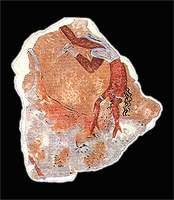Avaris
[6] As the main course of the Nile migrated eastward, its position at the hub of Egypt's delta emporia made it a major capital suitable for trade.
The name in the Egyptian language of the 2nd millennium BC was probably pronounced *Ḥaʔət-Waʕrəʔ “House of the Region” and denotes the capital of an administrative division of the land (wʕr.t).
A large mudbrick tomb has also been excavated to the west of the temple, where grave goods, such as copper swords, have been found.
Canaanite-style artifacts dated to the Tuthmosid or New Kingdom period suggest that a large part of the city's Semitic population remained in residence following its reconquest by the Egyptians.
[14] The pharaohs of the Eighteenth Dynasty set up a capital in Thebes and the palatial complex at Avaris was briefly abandoned, but areas such as the Temple of Seth and G6 region remained continuously occupied.
[27] Around 1700 BC a temple district to the Canaanite Asherah and the Egyptian Hathor was built in the eastern part of the city.
[27] Avaris, along with Tel Kabri in Israel and Alalakh in Syria, also has a record of Minoan civilization, which is otherwise quite rare in the Levant.
Manfred Bietak, an Austrian archaeologist and the excavator of Tell Dab'a, has speculated that there was close contact with the rulers of Avaris, and that the large building featuring the frescoes allowed the Minoans to have a ritual life in Egypt.


